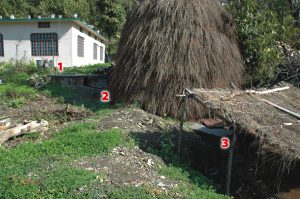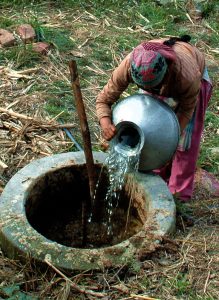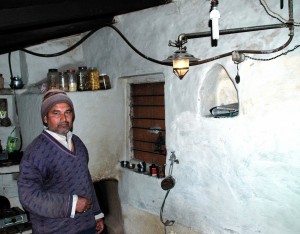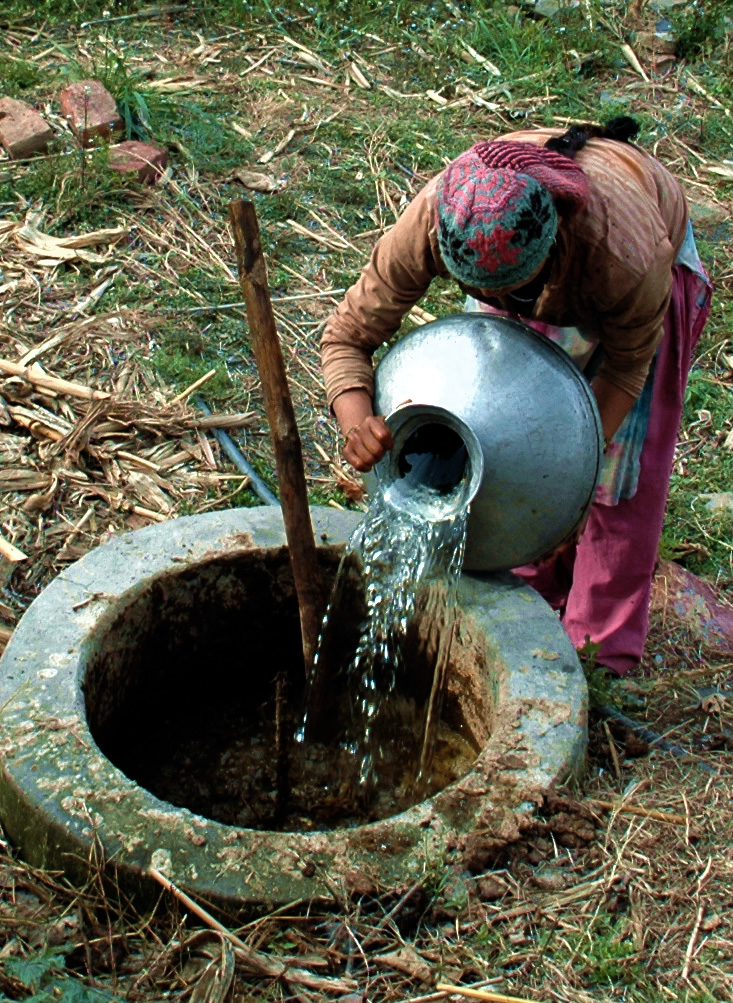A model program improves community’s self-reliance, generates fuel and provides digested dung for soil fertility.
Curt Davis
BioCycle April 2012, Vol. 53, No. 4, p. 46

Two Palar households have daisy-chained two DBDs together so that the outlet of one (1) feeds directly into the inlet of the second unit (2). All of the effluent exits under the roofed structure (3).
Grassroots also serves as the facilitating agent connecting end users with government subsidies aimed to promote biogas, and provides a small amount of funding from donations it receives. However, it has found that cost sharing, which obligates the stakeholder to provide for more than 50 percent of the total cost, has ensured the sustainability of the program (the average cost of a DBD was 18,000 Indian Rupees (INR) in 2009, approximately US$360 respectively).
In the village of Palar in the state of Himachal Pradesh, Grassroots worked with households to adopt biogas technology, reducing deforestation for fuel while improving health and sanitation as well as organic crop yields through use of the natural effluent by-product from the digesters. Grassroots began working in Palar in 2002 and over the past decade has been the impetus for construction of more than 2,000 biogas digesters throughout the western Indian Himalayas.

An equal portion of water and bovine dung is put in the mixing chamber. After thorough mixing, material goes into the digester chamber.
Biogas In Palar
Seventy-eight out of 83 households in Palar utilize biogas digesters. The five without digesters don’t have the cattle needed to support a digester (four head of cattle or buffalo are required for each 2 cubic meter (530 gallon) DBD unit). As part of a research study with Grassroots, 15 households in the village were randomly selected for individual interviews, in addition to a community focus group discussion, to learn more about use of DBDs. Since the majority of households in Palar devote their livelihoods to agriculture, the prime motivation for adopting biogas digesters was not as a fuel source but as a consistent source of organic fertilizer.
The processed slurry effluent or digestate has been shown to increase the quantity and quality of certain crops, such as potatoes and onions, over unprocessed dung alone. Traditionally, these farmers have had two options to increase soil fertility: dung or chemical fertilizer. The former has been used mainly on crops for home consumption and the latter used for fruits and vegetables intended for market (chemical fertilizers usually consist of urea and a 12:32:16 mix of NPK). While these farmers reported that digested dung is better overall than unprocessed dung, they continue to treat most vegetables exclusively grown for market with chemical fertilizers. An increasing number of households are beginning to only use the digested dung for vegetables intended for home consumption.
The DBD is made out of bricks and mortar and is built into the ground providing insulation during the winter. The system consists of a mixing chamber where an equal proportion of water and bovine dung is mixed (measured in equal units of liters and kilograms, respectively). Although some systems integrate human and other animal wastes, the DBDs constructed by Grassroots almost exclusively operate on bovine waste. Once the water and dung have been thoroughly mixed and undigested scraps of grass have been removed, a valve is opened allowing the mix to enter the underground half-dome-shaped digester chamber. Following a 55-day digestion process, there is enough gas pressure to push down on the digested slurry and move it along to the exit chamber where it comes out as a liquid that thickens as it dries. Approximately 40 kg (about 90 lbs) of dung is mixed daily for the DBD, providing for an average of four hours of cooking time in the summer and two hours in the winter.

Biogas is used for multiple purposes in this home, including operating a lamp, a 2-burner stove and an electric compact fluorescent light bulb.
Several factors favoring small-scale biogas have contributed to the success of the Palar program. To begin with, villagers are acutely aware of the ecological ramifications of deforestation that come as a result of overharvesting biomass, as well as the danger involved and time required to procure this fuel. While cleaner alternatives to firewood such as propane (LPG) exist, the village is located in such a remote area that the availability and reliability of LPG delivery is too unpredictable, and its price fluctuates (and it is an unsustainable fuel source). Therefore, the need for biogas is clear.
As has been discussed, the effluent has become such an effective fertilizer that it is gradually replacing the chemical fertilizers, which, like LPG, come from far away. And since almost all of the cattle and buffalo in Palar are stall-fed, obtaining dung is easy.
In fact, the introduction of biogas has created a solution for waste management overall, resulting in a village-wide movement toward better sanitation. In 2009, the village of Palar won the Total Sanitation Campaign (TSC), an annual award sponsored by the government of Himachal Pradesh awarded to a village that eliminates open defecation while improving overall sanitation in the community. Since winning the award, Palar has received much attention as representatives from around India have come to learn how to create a highly sanitary and sustainable community.
Curt Davis is an international development practitioner specializing in sustainable household energy. He holds a master of arts degree in Sustainable International Development from Brandeis University. Last year, he traveled to Palar to document the successful adoption of household biogas digesters as part of a professional practicum.










